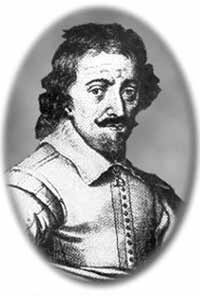 |
Lens Crafters Circa 1590: Invention of the Microscope
Every major field of science has benefited from the use of some form of microscope, an invention that dates back to the late 16th century and a modest Dutch eyeglass maker named Zacharias Janssen. While extremely rough in image quality and magnification compared to modern versions, the Janssen microscope was nonetheless a seminal advance in scientific instrumentation.
Janssen was the son of a spectacle maker named Hans Janssen, in Middleburg, Holland, and while Zacharias is credited with inventing the compound microscope, most historians surmise that his father must have played a vital role, since Zacharias was still in his teens in the 1590s. At that time, eyeglasses were beginning to be used widely among the populace, focusing a great deal of attention on optics and lenses. In fact, some historians credit both the Janssens and a fellow Dutch eyeglass maker, Hans Lippershey, with concurrent, though independent, invention of the microscope.
 Zacharias Janssen |
Historians are able to date the invention to the early 1590s thanks to Dutch diplomat William Boreel, a longtime family friend of the Janssens who wrote a letter to the French king in the 1650s detailing the origins of the microscope. He described a device that rose vertically from a brass tripod almost two and a half feet long. The main tube was an inch or two in diameter and contained an ebony disk at its base, with a concave lens at one end and a convex lens at the other; the combination of lenses enabled the instrument to bend light and enlarge images between three and nine times the size of the original specimen.
No early models of Janssen microscopes have survived, but a Middleburg museum has a microscope dated from 1595, bearing the Janssen name. The design is somewhat different, consisting of three tubes, two of which are draw tubes that can slide into the third, which acts as an outer casing. The microscope is handheld and can be focused by sliding the draw tube in or out while observing the sample, and is capable of magnifying images up to ten times their original size when extended to the maximum.
As ingenious as the Janssen invention was, it would be more than half a century before the instrument found widespread use among scientists. The Yorkshire scientist Henry Power was the first to publish observations made with a microscope, and in 1661 Marcello Malphigi used a microscope to provide clinching evidence in support of Harvey's theory of blood circulation when he discovered the capillary vessels in the lungs of a frog.
Micrographia author Robert Hooke was among the first to make significant improvements to the basic design, although he relied on London instrument maker Christopher Cock to actually build the instruments. Hooke's microscope shared common features with early telescopes: an eyecup to maintain the correct distance between the eye and eyepiece, separate draw tubes for focusing, and a ball and socket joint for inclining the body. For the optics, Hooke used a bi-convex objective lens placed in the snout, combined with an eyepiece lens and a tube or field lens. Unfortunately, the combination caused the lenses to suffer from significant chromatic and spherical aberration, yielding very poor images. He attempted to correct the aberrations by placing a small diaphragm into the optical pathway to reduce peripheral light rays and sharpen the image, but this only resulted in very dark samples. So he passed light generated from an oil lamp through a glass filled with water to diffuse the light and illuminate his specimens. But the images remained blurred.
It fell to a Dutch scientist, Anton van Leeuwenhoek, to make further improvements. Van Leeuwenhoek is sometimes popularly credited with the microscope's invention. He wasn't the inventor, but he was a great admirer of the Micrographia, and his instruments were the best of his era in terms of magnification: he achieved magnifying power up to 270 times larger than the actual size of the sample, using a single lens. He used his microscopes to describe bacteria harvested from tooth scrapings, and to study protozoans found in pond water.
By the dawn of the 18th century, British instrument designers had introduced improved versions of the tripod microscope invented by Edmund Culpeper. Other improvements included advanced focus mechanisms, although lens design remained rough and most instruments continued to be plagued by blurred images and optical aberrations. In the first half of the 19th century, dramatic improvements in optics were made, thanks to advanced glass formulations and the development of achromatic objective lenses. The latter had significantly reduced spherical aberration in the lens, making it free of color distortions.
The 20th century brought the introduction of instruments enabling the image to remain in focus when the microscopist changed magnification. Thanks to vastly improved resolution, contrast-enhancing techniques, fluorescent labeling, digital imaging, and countless other innovations, microscopy has revolutionized such diverse fields as chemistry, physics, materials science, microelectronics, and biology.
Today, it is possible to perform real-time fluorescence microscopy of living cells in their natural environment, while in 1999 Intel and Mattel collaborated on producing the $100 Intel Play QX3 Computer Microscope (since discontinued), bringing the instrument into the consumer marketplace. And in the spirit of the early pioneers of microscopic research, scientists at Florida State University have brought the field full circle, turning their advanced instruments on common everyday objects like that All-American staple, burgers and fries, detailing thin sections of wheat kernel, onion tissue, starch granules in potato tissue, and crystallized cheese proteins.
©1995 - 2024, AMERICAN PHYSICAL SOCIETY
APS encourages the redistribution of the materials included in this newspaper provided that attribution to the source is noted and the materials are not truncated or changed.
Associate Editor: Jennifer Ouellette
March 2004 (Volume 13, Number 3)
Articles in this Issue

